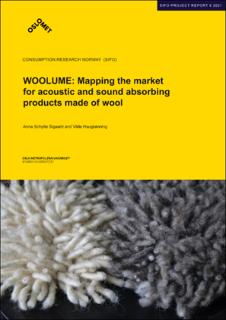WOOLUME: Mapping the market for acoustic and sound absorbing products made of wool
Anna Schytte Sigaard and Vilde Haugrønning
Abstract
This report is the first deliverable from work package 2 of the WOOLUME project. The main goal of WOOLUME is to explore different ways of using wool from Polish Mountain Sheep to achieve better utilisation of resources and value creation. The aim of the report has been to map the market for acoustic and sound absorbing products made of wool to examine the potential to introduce coarse wool as a material. This has been done through desktop research and interviews with a focus on the qualities of wool as a natural product. Findings show that though man-made materials dominate the market for acoustic products due to lower prices, wool is preferred as a material due to its natural properties as well as aesthetics. Producers using wool consider their products to be high-end, intended for people who want very good quality products and who are willing to pay a higher price to achieve this. However, few producers use coarse wool in these products, and many are made of pure Merino wool. Using Merino wool which is often considered of very fine quality due to the low micron-count does not correspond with the ideal of good utilisation of resources. Therefore, we are proposing to utilise coarse wool which today is discarded as a mere by-product to meat-production.
Merino could instead be used for products where fineness and softness are important factors such as for clothing. In addition, we argue for the rawness and uniqueness of the look of coarse wool as positive in terms of aesthetics and as something that adds to the position of acoustic products made of wool as high-end.

